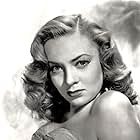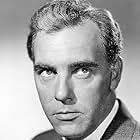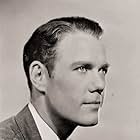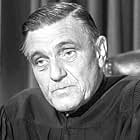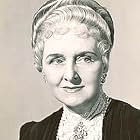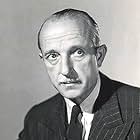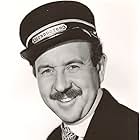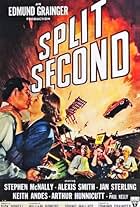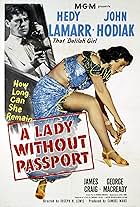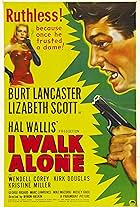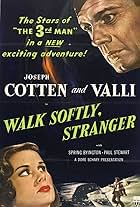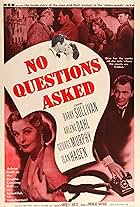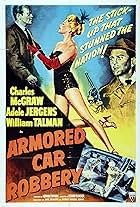ÉVALUATION IMDb
6,9/10
2,3 k
MA NOTE
Après qu'un homme endommagé au cerveau ait avoué son meurtre, la docteure Ann Lorrison tente de prouver son innocence.Après qu'un homme endommagé au cerveau ait avoué son meurtre, la docteure Ann Lorrison tente de prouver son innocence.Après qu'un homme endommagé au cerveau ait avoué son meurtre, la docteure Ann Lorrison tente de prouver son innocence.
- Prix
- 2 victoires au total
John Ridgely
- David Wallace
- (as John Ridgeley)
Robert Hyatt
- Richard Kenet
- (as Bobby Hyatt)
Jean Andren
- Nurse
- (uncredited)
Russell Arms
- Patient Awaiting Discharge Hearing
- (uncredited)
Avis en vedette
Robert Taylor in High Wall finds himself accused of wife Dorothy Patrick's murder. A head injury resulting from service as a pilot in the China-Burma-India Theater has rendered him susceptible to blackouts. When Patrick is strangled Taylor is a prime suspect, especially after he's caught racing from the crime scene.
It's a legal conundrum he's in. That head injury may just make him temporarily insane and Taylor's committed to a mental institution. There he meets psychiatrist Audrey Totter who's committed to rehabilitating him and loving him, not necessarily in that order in a given time in the film.
Though the story tends to go into the melodramatic the cast, especially Taylor give fine performances. I'm sure Taylor's background in the Navy during World War II helped him appreciate the plight of returning veterans like himself. Look also for great performances by Herbert Marshall as Patrick's boss and Vince Barnett as a blackmailing janitor with arthritis.
High Wall was Taylor's second film upon returning to MGM and it marked a step up from his first film Undercurrent. It still holds up well today.
It's a legal conundrum he's in. That head injury may just make him temporarily insane and Taylor's committed to a mental institution. There he meets psychiatrist Audrey Totter who's committed to rehabilitating him and loving him, not necessarily in that order in a given time in the film.
Though the story tends to go into the melodramatic the cast, especially Taylor give fine performances. I'm sure Taylor's background in the Navy during World War II helped him appreciate the plight of returning veterans like himself. Look also for great performances by Herbert Marshall as Patrick's boss and Vince Barnett as a blackmailing janitor with arthritis.
High Wall was Taylor's second film upon returning to MGM and it marked a step up from his first film Undercurrent. It still holds up well today.
This is probably Robert Taylor's first real film noir. He is revered in some circles for work a decade later such as Nicholas Ray's "Party Girl." I think he is excellent in "High Wall." He plays a decorated war vet who is accused of murder. Not just accused of murder but also but into a psychiatric hospital. Yikes. No fun at all. Except that the hypnotherapist assigned to his case is a beautiful woman who kind of likes him.
Cast in the role of the psychiatrist is one of the great staples of film noir, Audrey Totter. She is as always good. Better than good. What's intriguing here is that she is cast not as a femme fatale but as a career woman who is in every sense on the right side of the angels and the law.
Herbert Marshall turns in a superbly creepy performance also. I won't say much about his role other than that this is not really a whodunit. We know the answer to that very early.
It's an unusual, brave movie. It has flaws but is nevertheless very good.
Cast in the role of the psychiatrist is one of the great staples of film noir, Audrey Totter. She is as always good. Better than good. What's intriguing here is that she is cast not as a femme fatale but as a career woman who is in every sense on the right side of the angels and the law.
Herbert Marshall turns in a superbly creepy performance also. I won't say much about his role other than that this is not really a whodunit. We know the answer to that very early.
It's an unusual, brave movie. It has flaws but is nevertheless very good.
THE HIGH WALL gives Robert Taylor a chance to demonstrate that he was a very capable actor and much more than just a pretty face. Audrey Totter, as a psychiatrist who decides to help him prove he did not kill his wife, makes a strong impression opposite him. And Herbert Marshall is quietly effective as a mysterious man who knows the truth.
All of it is directed in brisk film noir fashion by Curtis Bernhardt with the accent on dark shadows and rainy streets to give it the proper noir atmosphere.
Rather than tell the plot, I'll just say that the story moves swiftly and keeps the viewer absorbed from start to finish. It's a well-paced thriller that makes use of psychiatric trends that may date the film today--but it's all done with such authority that whatever script contrivances are present don't really matter. It's intense and absorbing all the way in true film noir style. Taylor has seldom been more convincing as the distraught bomber pilot trying to find out whether he killed his wife or not.
All of it is directed in brisk film noir fashion by Curtis Bernhardt with the accent on dark shadows and rainy streets to give it the proper noir atmosphere.
Rather than tell the plot, I'll just say that the story moves swiftly and keeps the viewer absorbed from start to finish. It's a well-paced thriller that makes use of psychiatric trends that may date the film today--but it's all done with such authority that whatever script contrivances are present don't really matter. It's intense and absorbing all the way in true film noir style. Taylor has seldom been more convincing as the distraught bomber pilot trying to find out whether he killed his wife or not.
After a lonely drink (in a beautiful black-and-white barroom), religious book publisher Herbert Marshall (as Willard Whitcombe) goes to his office and inquires about pretty secretary Dorothy Patrick (as Helen). He is told her husband, World War II bomber pilot Robert Taylor (as Steven Kenet), has returned to the USA from Burma. Next, we see Mr. Taylor driving his apparently dead wife off the road, toppling their car. It turns out the beautiful blonde was strangled and Taylor is suffering from post-War stress and a brain injury. Taylor has a blood clot on the brain, causing some theatrical hands-on-his-headaches. Although he doesn't recall killing his wife, Taylor confesses and is committed to a psychiatric hospital. Attractive (and single) psychiatrist Audrey Totter (as Ann Lorrison) is assigned Taylor's case. She wonders if he's aiming to get off on "temporary insanity" – or, perhaps the (handsome) widower is innocent...
As of this writing, we are in an era where many filmmakers consider the "shaky camera" technique (called "hand held camera" by insiders) a high form of cinematic art. If you're dizzy after watching one of these wobbly movies, "High Wall" is a perfect antidote...
Cinematographer Paul Vogel's eloquence camera movements begin swirling through the opening bar scene, and are marvelous throughout. Guided skillfully by director Curtis Bernhardt, the camera helps tell us about the characters, and moves the story. Producer Robert Lord's team also know when to stop, as in the extra second we are given to read the words on the door of Mr. Marshall's office. Marshall gets one of the film's highlights – watch how he handles handyman Vince Barnett (Henry Cronner) with the hook of an umbrella. Marshall is worthy of a "Best Supporting Actor" award. It's also nice to see veteran H.B. Warner as a loony mental patient. The romance is routine and ending questionable, but "High Wall" is well worth scaling.
******* High Wall (12/17/47) Curtis Bernhardt ~ Robert Taylor, Audrey Totter, Herbert Marshall, Vince Barnett
As of this writing, we are in an era where many filmmakers consider the "shaky camera" technique (called "hand held camera" by insiders) a high form of cinematic art. If you're dizzy after watching one of these wobbly movies, "High Wall" is a perfect antidote...
Cinematographer Paul Vogel's eloquence camera movements begin swirling through the opening bar scene, and are marvelous throughout. Guided skillfully by director Curtis Bernhardt, the camera helps tell us about the characters, and moves the story. Producer Robert Lord's team also know when to stop, as in the extra second we are given to read the words on the door of Mr. Marshall's office. Marshall gets one of the film's highlights – watch how he handles handyman Vince Barnett (Henry Cronner) with the hook of an umbrella. Marshall is worthy of a "Best Supporting Actor" award. It's also nice to see veteran H.B. Warner as a loony mental patient. The romance is routine and ending questionable, but "High Wall" is well worth scaling.
******* High Wall (12/17/47) Curtis Bernhardt ~ Robert Taylor, Audrey Totter, Herbert Marshall, Vince Barnett
The former WWII pilot Steven Kenet (Robert Taylor) is captured by the police after driving his car off the road into a river with his deceased wife. He confesses that he killed his wife and is sent to a psychiatric hospital for medical evaluation. Kenet has a brain injury from the war that provokes amnesia and the justice department needs to know whether he may be charged of murder or not. Dr. Ann Lorrison (Audrey Totter) is assigned to treat him and offers a surgery to cure him but refused by Kenet. When Kenet is visited by the super of the apartment building where the boss of his wife lives, he insinuates that Willard I. Whitcombe (Herbert Marshall) killed his wife in his apartment. Now Kenet wants to recover his memory and accepts to be submitted to a treatment by Dr. Lorrison.
"High Wall" is a film-noir combined with melodrama and romance. The lead story is not bad, but the romance of Kenet and Lorrison has no chemistry and is hard to believe. The black-and-white cinematography is wonderful and the happy-ending is acceptable. My vote is seven.
Title (Brazil): "Muro de Trevas" ("Wall of Darkness")
"High Wall" is a film-noir combined with melodrama and romance. The lead story is not bad, but the romance of Kenet and Lorrison has no chemistry and is hard to believe. The black-and-white cinematography is wonderful and the happy-ending is acceptable. My vote is seven.
Title (Brazil): "Muro de Trevas" ("Wall of Darkness")
Le saviez-vous
- AnecdotesBoth Audrey Totter and Robert Taylor relished making this film - Totter, because she got to play a professional woman as she did in Lady in the Lake (1946), and Taylor, because he got to act and not just be a "pretty boy".
- Gaffes(at around 9 mins) A group of doctors is looking at Kenet's skull X-rays. The X-rays are hung behind the illuminated frosted glass panels, so viewers can see the X-rays, but the doctors could not. And the X-ray as the viewer sees it is oriented correctly to show a left-side hematoma, but to the doctors, the X-ray is reversed, meaning the hematoma would be on the right.
- Citations
Steven Kenet: All this is confidential between doctor and patient isn't it? You're in a hurry to get in and report this aren't you? Well I can't stop you but just remember, you're the one who sold me on the idea of surgery, of fighting for an acquittal. Why did you bother?
- ConnexionsFeatured in Noir Alley: High Wall (2017)
- Bandes originalesNocturne Op. 9, No. 2
(uncredited)
Composed by Frédéric Chopin
[The piano piece Slocum plays on the phonograph for Steve when they first meet at dinner]
Meilleurs choix
Connectez-vous pour évaluer et surveiller les recommandations personnalisées
- How long is High Wall?Propulsé par Alexa
Détails
Box-office
- Budget
- 1 844 000 $ US (estimation)
- Durée1 heure 39 minutes
- Couleur
- Rapport de forme
- 1.37 : 1
Contribuer à cette page
Suggérer une modification ou ajouter du contenu manquant











